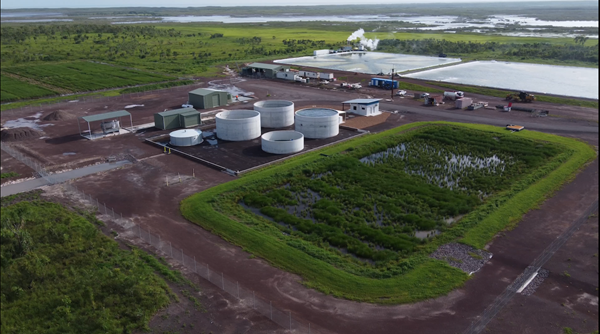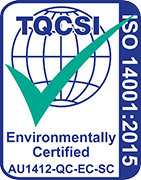
What is PFAS?
11 March, 2022
A growing number of media reports of water contamination near airports and Defence bases in recent years have had some concerned residents asking the question, What is PFAS?
The more accurate question would be, “What are PFAS?” as those four letters actually represent thousands of man-made chemicals that are now classified as emerging contaminants of concern. It is the virtually indestructible nature of the PFAS compounds and the fact they remain detectable in the bloodstream for years after someone is exposed that has raised alarm bells about PFAS contamination.
What are PFAS compounds?
PFAS is the common term used for both per-fluoroalkyl and poly-fluoroalkyl compounds – a family of thousands of man-made chemicals that have been in production since the 1950s.
The number of atoms in each of these chemical compounds can be different, leading to PFAS compounds being categorised as short-chain PFAS or long-chain PFAS compounds. A common feature of all the PFAS compounds is that some, or all, of the links between the hydrogen atoms and carbon chain are replaced by fluorine atoms. These carbon-fluorine bonds are very strong and help to make PFAS resistant to chemical, thermal and biological degradation.
PFAS compounds can make products oil, water, and stain resistant, as well as increasing chemical and thermal stability, and reducing friction. This is why PFAS is used to manufacture many items including waterproof and stain-resistant coatings for textiles, paper and cardboard, metal plating paints, pesticides, greaseproof paper, cosmetics, lubricants, and fire-fighting foams.
Where does PFAS in our environment come from?
Since 2000, there has been growing awareness and concern about the persistent and bio-accumulative nature of several PFAS compounds. Initially the focus was on two long-chain PFAS compounds; perfluorooctane sulfonate (PFOS) and perfluorooctanoate (PFOA). These two compounds have been widely used in firefighting foams and stain and water-resistant products. PFOS and PFOA have subsequently been detected in soil, sediment, surface water and groundwater, as well is in plant and animal tissue around the world.
Even in places where PFOS and PFOA are not manufactured, these contaminants and other PFAS compounds are still being detected in areas due to:
- Their chemical properties and persistent nature
- Direct use of products, such as the application of fire-fighting foams
- Accidental release of fugitive emissions, such as exhaust gases from sites where PFAS containing products are used or processed
- Contamination of wastewater, stormwater, or groundwater in part due to the improper disposal of solid wastes, sludges, or liquids
- Breakdown and leaching of products containing PFAS compounds while they are being manufactured or are in use in the environment
- Transfer of PFAS containing substances to landfills or wastewater drinking plants from the public and industry
- Leaching from waste disposal points, chemical storage, or landfill into the environment.
The Australian Government is currently developing the Industrial Chemicals Environmental Management Standard (ICheMS), which will provide a national framework for the regulation of use, storage, handling, and disposal of chemicals, including PFAS compounds, in Australia. Although the international community faces similar challenges due to regrettable substitution and the management of legacy wastes and products.
Why PFAS compounds are dangerous
The chemical properties that have made PFAS compounds so useful and lead to their widespread use, that has raised alarm bells about the danger it presents to our environment, animals, and people. PFAS compounds do not easily break down or dissipate in the environment and remain detectable in the bloodstream for years after someone is exposed to the chemicals.
Since 2000, research into the impact of PFAS has mainly focused on the long-chain PFAS compounds, PFOS and PFOA, as these are key contributors to pollution at contaminated sites, such as fire training grounds at airports, Defence bases, fire stations, and fuel refineries.
As a result, there has been an industry shift towards replacing long-chain PFAS with short-chain alternatives – but there needs to be more research into the long-term impact of these alternatives, particularly when it comes to waste treatment and storage facilities and the contamination of drinking water.
Short-chain PFAS retain the characteristic of extreme persistency but are also highly mobile, meaning the compounds can easily spread into drinking water resources, surface water, soil and plants grown near contamination sources. Adding to the growing concern around short-chain PFAS is the increased cost and inefficiencies seen in treatment technologies typically used for PFAS treatment when applied to these compounds, particularly PFBS and PFBA.
An Expert Health Panel tasked with reviewing PFAS health effects by the Australian Government reported in 2018 that ‘although the evidence on health effects associated with PFAS exposure is limited, the current reviews of health and scientific research provide fairly consistent reports of associations with several health outcomes, in particular: increased cholesterol, increased uric acid, reduced kidney function, altered markers of immunological response, levels of thyroid and sex hormones, later menarche and earlier menopause, and lower birth weight.’ The same panel reported there was no clear evidence that PFAS exposure is associated with an increase in overall cancer risk.
Of course, people are not the only living things affected by contamination with research finding some PFAS compounds bio-accumulating in fish, and in plants growing near a source of soluble PFAS compounds. The observation is often made that PFAS impacted waterways ‘look healthy’, with fish, aquatic organisms and bird populations present in abundance. However, it is the bioaccumulation and potential for intergenerational effects which is a cause for alarm.
What are some of the technologies that exist to remove PFAS?
The main focus for innovation in liquid PFAS removal has been the treatment of contaminated drinking water, firefighting systems, concentrates and groundwater. Unfortunately, most of the methods that are developed for PFAS extraction from these are too expensive or inefficient to be used to treat the high-volume low concentration scenario of wastewater, or the high concentration and high level of co-contamination present in landfill leachate.
The Water & Carbon Group has developed a Low-Energy PFAS Extraction (LEEF) System to treat wastewater and landfill leachate. The technology combines a multiple step foam fractionation and enclosed solar distilling system to remove regulated PFAS contaminants to the limit of detection (LoR).
The modular system uses minimal energy and can be assembled to treat any volume of water. The technology is designed to minimise operational costs by eliminating the need for chemical additives, consumables, or excessive waste transport.
For more information about the LEEF System®, contact us.
Footnotes
References:
Australian Government 2018, PFAS Expert Panel - Report to the Minister March 2018, http://www.health.gov.au/internet/main/publishing.nsf/Content/ohp-pfas-expert-panel.htm





